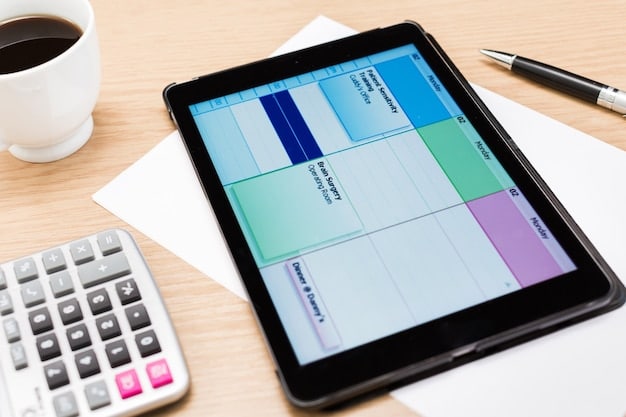Master Your Spending: Online Budgeting Tools for Smart Shopping

Using online budgeting tools can significantly aid in tracking and controlling online shopping habits by providing insights into spending patterns, setting financial limits, and promoting mindful purchasing decisions.
Do you find yourself clicking “add to cart” a little too often? You’re not alone. Many people struggle with overspending when it comes to online shopping. But, there’s a solution. Learning how to use online budgeting tools to track and control your online shopping habits can empower you to take charge of your finances and curb impulse buys.
Understanding the Allure of Online Shopping and Its Impact on Your Budget
Online shopping offers unparalleled convenience, a vast selection of products, and irresistible deals. However, this ease and accessibility can easily lead to overspending and budget imbalance. Understanding the psychology behind your online shopping habits is the first step towards regaining control.
The Psychology of Online Spending
Several factors contribute to the allure of online shopping. The convenience of shopping from the comfort of your home, the constant stream of promotions and discounts, and the ease of using digital payment methods all play a role. These factors can create a sense of detachment from the actual money being spent, making it easier to overspend.
Recognizing the Signs of Problematic Online Shopping
Are you spending more than you earn? Do you often buy things you don’t need just because they’re on sale? Are you hiding your online purchases from your family or partner? These are all signs that your online shopping habits may be becoming problematic and affecting your overall financial health.

Here are some tips to help you recognize and address problematic online shopping.
- Track your spending: Use a budgeting tool or spreadsheet to monitor your online purchases.
- Set spending limits: Establish realistic spending limits for online shopping each month.
- Identify triggers: Determine what situations or emotions lead to impulse buys.
- Unsubscribe from marketing emails: Reduce temptation by unsubscribing from promotional emails.
By understanding the allure of online shopping and recognizing the signs of problematic spending, you can better prepare yourself to take control of your finances. The next step involves exploring the tools available to help you manage your online spending effectively.
Exploring Online Budgeting Tools: A Comprehensive Overview
Online budgeting tools offer a range of features designed to help you track your spending, create budgets, and achieve your financial goals. From simple spreadsheets to sophisticated apps, there’s a tool to suit every need and preference. Understanding the different types of tools available can help you choose the one that’s right for you.
Types of Online Budgeting Tools
Online budgeting tools come in various forms, each with its own set of features and benefits. Some popular options include: budgeting apps, budgeting spreadsheets, and personal finance software.
Features to Look for in a Budgeting Tool
The ideal budgeting tool should offer a combination of features that streamline tracking, analysis, and control over spending. Prioritize tools that allow for automation, customization, and clear visualization of your financial data.
Here is a list of features to consider when choosing a budget tracking tool:
- Automated transaction tracking: Automatically import transactions from your bank accounts and credit cards.
- Budgeting and goal setting: Create budgets for different categories and set financial goals.
- Spending analysis: Visualize your spending patterns and identify areas where you can save.
- Mobile accessibility: Access your budget and track your spending on the go.
Selecting the right online budgeting tool hinges on carefully assessing your individual needs and financial objectives. By having a clear understanding of what you’re looking for, you can confidently choose a tool that will empower you to achieve your financial goals.
Setting Up Your Online Budgeting Tool: A Step-by-Step Guide
Once you’ve chosen an online budgeting tool, the next step is to set it up and start tracking your spending. The setup process may vary depending on the tool you choose, but the basic steps are generally the same. Follow these steps to create an effective budget.
Linking Your Accounts
Most online budgeting tools allow you to link your bank accounts, credit cards, and other financial accounts. This allows the tool to automatically import your transactions, saving you the hassle of manually entering them. Make sure the tool uses secure encryption to protect your financial information.
Creating Budget Categories
Budget categories are essential for organizing your spending and identifying areas where you can cut back. Common budget categories include housing, transportation, food, entertainment, and online shopping. Create categories that are relevant to your spending habits.

To effectively categorize your spending, consider the following tips:
- Start with broad categories and then break them down into more specific subcategories.
- Be consistent with your categorization to ensure accurate tracking.
- Review and adjust your categories as needed to reflect changes in your spending habits.
By carefully setting up your online budgeting tool and linking your accounts, you’ll be well on your way to effectively tracking and controlling your online spending habits. In order to get the best results, you must properly maintain the platform that you choose.
Tracking Your Online Shopping Habits: Identifying Spending Patterns
Tracking your spending is crucial for identifying patterns and areas where you may be overspending. Online budgeting tools provide detailed reports and visualizations that make it easy to see where your money is going. Regularly reviewing your spending habits can reveal valuable insights into your financial behavior.
Analyzing Spending Reports
Most online budgeting tools offer various types of spending reports, such as monthly summaries, category breakdowns, and transaction histories. These reports can help you identify trends and patterns in your spending, such as which categories you’re overspending in or which retailers you shop at most frequently.
Identifying Triggers for Impulse Buys
Impulse buys are often triggered by emotions, stress, or exposure to marketing materials. Tracking your spending can help you identify the triggers that lead to these purchases. Once you know your triggers, you can develop strategies to avoid them.
Consider these strategies to combat impulse buys:
- Wait 24 hours before making a purchase: Give yourself time to consider whether you really need the item.
- Avoid browsing online stores when you’re feeling stressed or emotional.
- Unsubscribe from marketing emails and social media ads.
By diligently tracking your online shopping habits, you’ll gain a deeper understanding of your spending behavior, enabling you to make informed decisions and avoid impulsive purchases. Once you have a better understanding of where your money is going, you can take steps to optimize your budget.
Setting Realistic Spending Limits: Allocating Funds for Online Shopping
Setting realistic spending limits is essential for staying on track with your budget and avoiding overspending. Online budgeting tools allow you to set limits for different categories, including online shopping. By allocating a specific amount of funds for online purchases each month, you can control your spending and achieve your financial goals.
Calculating Your Discretionary Income
Before setting spending limits, it’s important to calculate your discretionary income, which is the amount of money you have left over after paying for essential expenses. This will help you determine how much you can realistically afford to spend on online shopping.
Creating a Flexible Budget
A flexible budget allows you to adjust your spending limits based on your income and expenses. This can be particularly helpful if you have variable income or unexpected expenses. Online budgeting tools make it easy to adjust your budget as needed.
Here are some tips for creating a flexible budget:
- Track your income and expenses closely.
- Set realistic spending limits for each category.
- Be prepared to adjust your budget as needed.
By setting realistic spending limits, you can effectively manage your online shopping habits and stay on track with your financial goals. Taking active steps to manage your budget will yield the best results over time.
Staying on Track: Monitoring Progress and Adjusting Your Budget
Monitoring your progress and adjusting your budget are crucial for long-term success. Online budgeting tools provide real-time feedback on your spending, allowing you to see how you’re tracking against your budget. Regularly reviewing your budget and making adjustments as needed will help you stay on course and achieve your financial goals.
Reviewing Your Budget Regularly
Make it a habit to review your budget at least once a week. This will help you identify any areas where you’re overspending and make adjustments as needed. Online budgeting tools provide visual reports that make it easy to see how you’re tracking against your budget.
Adjusting Your Budget as Needed
Your budget should be a living document that evolves as your financial situation changes. As your income, expenses, and goals change, be sure to adjust your budget accordingly. Online budgeting tools make it easy to make these adjustments.
Consider these strategies to ensure you stay on track:
- Set reminders to review your budget regularly.
- Be honest with yourself about your spending habits.
- Don’t be afraid to seek help from a financial advisor.
Consistent monitoring and timely adjustments are essential for maintaining a healthy budget and achieving lasting financial success. By using online budgeting tools effectively and remaining vigilant about your spending habits, you can confidently navigate your financial journey and live a more secure and fulfilling life.
| Key Point | Brief Description |
|---|---|
| 💡 Understand Spending | Recognize the allure of online shopping and its impact on your budget. |
| 🛠️ Set Up Tools | Link accounts and create budget categories in your online tool. |
| 📊 Track Habits | Analyze reports to identify spending patterns and triggers. |
| 🎯 Set Limits | Allocate specific funds for online shopping and create a flexible budget. |
Frequently Asked Questions
▼
Online budgeting tools provide automated tracking, spending analysis, and goal-setting features, making it easier to manage your finances and control online shopping habits.
▼
Consider factors like ease of use, features offered (automated tracking, reporting), mobile accessibility, and whether it aligns with your financial goals when selecting a budgeting tool.
▼
Yes, most online budgeting tools allow you to link multiple bank accounts, credit cards, and investment accounts for a comprehensive view of your financial situation.
▼
It’s recommended to review your budget regularly, at least once a week, to monitor your spending, identify areas for improvement, and make necessary adjustments to stay on track.
▼
Identify your triggers, set stricter spending limits, unsubscribe from promotional emails, and consider seeking help from a financial advisor to develop healthier spending habits.
Conclusion
Taking control of your online shopping habits is achievable with the right tools and strategies. By understanding the psychology of online spending, exploring online budgeting tools, and setting realistic spending limits, you can gain greater control over your finances and achieve your financial goals.





